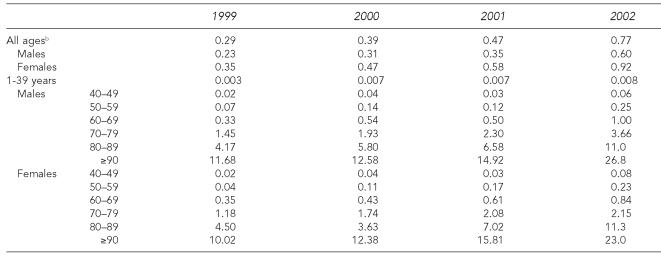A review of U.S. death certificate data for the period 1999 through 2002, the latest year for which statistics are available, indicates an increase in the annual number of deaths attributed to enterocolitis due to Clostridium difficile, ICD-10 code A04.7. In 1999, there were 793 deaths of 2.39 million total deaths in which this code was listed as the underlying cause of death and 2,195 of 2.44 million deaths in 2002, a 2.7-fold increase in the age-adjusted rates (Table). Similarly, the number of deaths with enterocolitis due to C. difficile listed on death certificates as total mentions (combined number of the immediate cause, underlying cause, contributing to the underlying cause, or as a significant condition not contributing to the underlying cause) increased from 1,545 in 1999 to 3,514 in 2002, a 2.3-fold increase.1
Table.
Age- and sex-specific ratesa of enterocolitis due to Clostridium difficile (as the underlying cause of death) in the United States, 1999 through 2002
Sources: Public Use Data Tape Documentation. Multiple cause of death for ICD-10 1999–2002 data. Department of Health and Human Services (US), Public Health Service, National Center for Health Statistics: Hyattsville (MD): 2002.
Population census data.
Age- and sex-specific rates per 100,000 population. Rates are based on enterocolitis due to Clostridium difficile as the underlying cause of death and on population census data.
Age-adjusted rates per 100,000 population using the year 2000 standard.
Age-and sex-specific rates for males and females (Table) based on underlying cause of death on certificates1 and population census data also show considerable increases for 1999 through 2002. Rates increased with age and the overall rate for females was higher than for males, while elderly males and females had similarly high rates.
Anti-infective medications,2 gastric acid suppressive agents,3 and chemotherapeutic drugs4 have been implicated as likely or possible causes of enterocolitis due to C. difficile in hospital- and community-acquired settings. It is not possible to determine if medications are mentioned as causes of enterocolitis on death certificates without obtaining copies of them. Recent studies have also reported the identification of a severe epidemic strain of the bacterium in the U.S.,5 but it is not known if this strain contributed to the increase in deaths during this period. Also, although toxigenic C. difficile detection by tissue culture cytotoxin assay is often considered as the “gold standard,” a rapid sensitive and specific assay has been developed,6 which if widely adopted, might have contributed to diagnosis and the increase in the number of deaths.
In summary, death certificate data indicate recent increases in deaths associated with enterocolitis due to C. difficile. Continued surveillance of mortality related to this infection using death certificate data indicates national trends and would help determine the need for increased emphasis on prevention, early detection, and treatment.
REFERENCES
- 1.Public Use Data Tape Documentation. Multiple cause of death for ICD-10 1999–2002 data. Hyattsville (MD): Department of Health and Human Services (US), Public Health Service, National Center for Health Statistics; 2002. [Google Scholar]
- 2.Pepin J, Valiquette L, Alary M-E, Villemure P, Pelletier A, Forget K, et al. Clostridium difficile-associated diarrhea in a region of Quebec from 1991 to 2003: a changing pattern of disease severity. CMAJ. 2004;171:466–72. doi: 10.1503/cmaj.1041104. [DOI] [PMC free article] [PubMed] [Google Scholar]
- 3.Dial S, Delaney JAC, Barkun AN, Suissa S. Use of gastric acid-suppressive agents and the risk of community-acquired Clostridium difficile-associated disease. JAMA. 2005;294:2989–95. doi: 10.1001/jama.294.23.2989. [DOI] [PubMed] [Google Scholar]
- 4.Anand A, Glatt AE. Clostridium difficileinfection associated with antineoplastic chemotherapy: a review. Clin Infect Dis. 1993;17:109–13. doi: 10.1093/clinids/17.1.109. [DOI] [PubMed] [Google Scholar]
- 5.McDonald LC, Killgore GE, Thompson A, Owens RC, Kazakova SV, Sambol SP, et al. An epidemic, toxin gene-variant strain of Clostridium difficile. N Engl J Med. 2005;353:2433–41. doi: 10.1056/NEJMoa051590. [DOI] [PubMed] [Google Scholar]
- 6.Belanger SD, Boissinot M, Clairoux N, Picard FJ, Bergeron MG. Rapid detection of Clostridium difficle in feces by real-time PCR. J Clin Microbiol. 2003;41:730–4. doi: 10.1128/JCM.41.2.730-734.2003. [DOI] [PMC free article] [PubMed] [Google Scholar]



